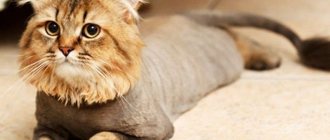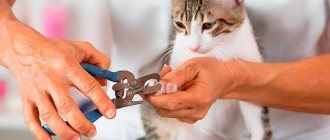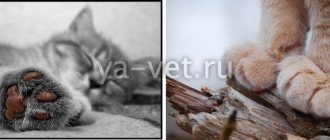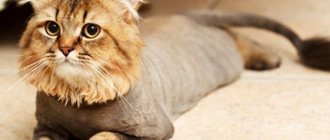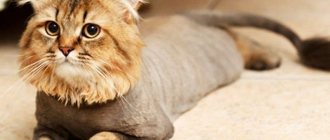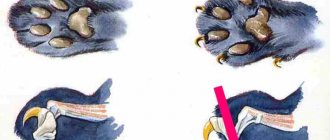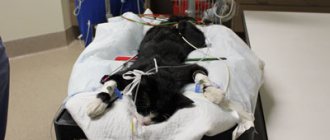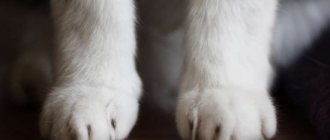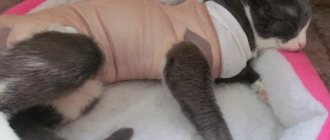The “soft paws” procedure is a surgical procedure performed to remove claws. Together with them, the surgeon also removes the growth zone. It is advisable to resort to manipulation for pet owners who constantly tear up furniture, and scratching posts do not help at all. The operation can also be performed in a situation where the animal is overly aggressive and strives to scratch the owner at any opportunity.
Declaw removal - onychectomy: pros and cons
Onychectomy is a surgical procedure that involves carefully removing the upper phalanges on the animal’s paws, followed by suturing.
The wounds are treated with an ointment with an anesthetic effect, and then bandaged. This intervention is performed under anesthesia. The owner will have to care for the cat for some time after declawing, following all the doctor’s orders.
Onychectomy is performed for medical reasons:
- damage to the claw phalanx with risks of finger amputation;
- advanced fungal diseases of the claws;
- ingrown claw;
- uncontrollable aggression in an animal.
There are no other indications for this intervention. But despite this, many owners deprive cats of natural protection and many important skills necessary to exist in the environment, solely at their own request.
Of course, if the cat does not go outside, such an operation will not make him particularly damaged. But we still recommend that you carefully consider this idea and decide to perform onychecotomy, correctly weighing all the pros and cons.
Necessity or cruelty?
The Ministry of Agriculture of the Russian Federation provided clarification on this issue. In his opinion, onychectomy must meet the requirements of humane treatment of animals and its implementation can be determined solely by veterinary indications. Relations in the field of treatment of animals are regulated by Federal Law of December 27, 2022 No. 498-FZ “On the Responsible Treatment of Animals and on Amendments into certain legislative acts of the Russian Federation.” According to the Law, cruelty to an animal is treatment that has led or may lead to the death, injury or other damage to the health of the animal (including torture of the animal, including hunger, thirst, beatings, and other actions). Carrying out onychectomy, if it is not dictated by veterinary indications, may be regarded as cruelty to the animal
The Department of Veterinary Medicine of the Ministry of Agriculture of Russia draws attention to the need to use humane methods for correcting animal behavior at home and warns against the inadmissibility of onychectomy without veterinary indications
Advantages and disadvantages of declawing cats
It doesn't take long to remove a cat's claws. But are there any advantages from this? Yes, I have. This is the impossibility of damaging furniture and the absence of scratches on the skin of household members.
But the disadvantages include a number of points:
- anesthesia is not just a dream, but stress for the body;
- the animal is in great pain for a very long time after the operation. The pain is dulled with various painkillers, which is also considered an intervention in the body;
- the phalanx may grow back and require repeated surgery;
- This is real stress for a cat, which not every animal experiences without consequences.
- a cat without claws is defenseless, and any trip outside can end in disaster;
- as a result of onychectomy and a feeling of vulnerability, the pet may use its teeth;
- the pet’s character changes, it may become withdrawn;
- Difficulties with the toilet: sometimes cats refuse to go to the litter box due to the inability to rake;
- the animal will never step on the entire foot completely again in its life, which affects its gait.
Advantages and disadvantages of soft paw surgery
If owners don't know how to protect themselves and their furniture from scratches, it's important to learn the pros and cons of cat declawing. Depending on this, you can make the right decision regarding the operation.
Benefits of declawing:
- The pet will no longer scratch household members and damage furniture.
- If the claws are pulled out, there will be no need to install scratching posts indoors.
- With the right rehabilitation process, the animal will be able to return to normal life within a week.
Disadvantages of surgical removal:
- The stressful situation of the animal after surgery can disrupt the usual lifestyle of all household members.
- There is a high risk of developing various complications after surgery.
- The cat will begin to learn to walk again.
- An animal without claws will not survive on the street.
There are many more disadvantages to this procedure than advantages. Therefore, you need to weigh the pros and cons.
Arguments
Heated debates regarding velvet paw surgery arise based on arguments for and against the intervention. The fact is that all statements in favor of the operation sound a little cynical; after all, you don’t have to get a cat if it brings so much inconvenience.
What are owners guided by when resorting to onychectomy? In fact, every cat owner gives one of the following four arguments:
- There are small children in the house.
- The cat was showing aggression.
- Fear of injury and infection.
- Fears about damage to furniture.
Opponents of velvet paws never tire of insisting that there are alternatives to each item, which are not always convenient for the cat, but there are. There are many more negative consequences and risks. The truth is that all possible risks can be divided into obligatory and probable.
Consequences that cannot be avoided, even if the operation is performed at an early age:
- After declawing and a period of rehabilitation, the cat learns to walk again, but it will never be able to confidently jump and run.
- While walking at a normal pace, the cat will fall, especially if the flooring is slippery.
- The animal's gait changes, which over time leads to unnatural abrasion of the joints and problems with the musculoskeletal system.
- The cat stops playing, which is detrimental to the psyche of naturally active four-legged animals.
- While eating, four-legged animals often take out pieces of meat with their paws; after removing the claws, the cat will not be able to do this.
- If the claws on the front paws are removed, the animal stops washing itself, or rather, it will not be able to wash itself fully.
- When claws are removed from the hind and front paws, the cat will not be able to scratch itself, and the obsessive itching leads to irritability and increasing stress.
Once declawed, lost skills cannot be regained, even if you intentionally train your cat. The tailed one feels inferior and defenseless, and it behaves accordingly.
Lately, more and more people are deciding to shelter adult cats that were abandoned by their previous owners, that is, they are getting animals whose claws were previously removed. It is important for such owners to know and understand the pros and cons of the procedure, since all the consequences will appear sooner or later.
The cat experiences pain when walking and after surgery. So-called phantom pain can bother the animal for life or for several years after declawing. There are no methods or therapy for this disease; people are treated experimentally, animals are not treated at all.
Impaired coordination and neurological disorders are the most obvious and disastrous consequences, leading to fearfulness and constant nervousness of the animal. Due to atrophy of the paw muscles and a feeling of defenselessness, most animals develop aggression towards all living things. Do not forget that a cat, in addition to claws, has teeth, and if you decide to take a cat after an onychectomy in order to protect the child from scratches... you are feeding the wrong motives.
Complications after surgery
Declawing is a very complex procedure from a surgical point of view. When all phalanges of the fingers are removed, the risk of complications is almost 100%. There are more than 20 types of complications that are likely to occur; below are only the most statistically common ones.
The consequences of anesthesia are onychectomy, this is a long operation where the surgeon needs to choose: rush and spare the animal’s heart or take his time and perform the procedure as carefully as possible. Most often, the doctor is inclined to the second option, which leads to an increase in the dose of anesthesia.
The medicine “under which” the cat sleeps is in any case a drug, that is, a toxin. Any drug is harmful to the functioning of the heart, liver and kidneys. If the operation is carried out for medical reasons, not all of the cat’s claws are removed, that is, the operation does not last long and the effect of anesthesia is not so dangerous. Conclusion: the risks associated with such a lengthy operation are not worth even the hypothetical benefits.
Before performing an onychectomy, the cat must be examined for cardiac, renal and liver failure! The operation is contraindicated in animals with neurological disorders unless life-saving is involved.
Having chosen the speed of the operation as a priority, the surgeon cannot guarantee the quality and here a new complication arises - suppuration after suturing wounds , re-growth of claws, damage to nerve nodes. All three consequences are unbearable pain and a negative impact on the animal’s psyche and immune system. Re-growth of claws obliges the owner to undergo repeated surgery after a period of rehabilitation or doom the pet to pain for the rest of its life.
Almost always, after surgery, the sutures come apart . Since the paws are very mobile, open wounds on them bleed heavily and take a long time to heal. With such a complication, there are two options: wait and hope, or re-introduce the cat into anesthesia to close the broken sutures.
After surgery, the cat must wear tight bandages on all paws. Experience shows that animals are very resistant and simply chew through the protective covers. In addition, the tailed one is scared and in pain, and the stitches itch. As soon as the cat rips off the bandage, it begins to chew the threads, which opens the stitches and causes an infection. The consequence is purulent inflammation of the sutures, which need to be re-wrapped in a bandage. Simply put, one finger festers, it is wrapped up - the infection spreads to all fingers.
How to make your cat's claws safe?
Sometimes trimming cats' claws is necessary to protect other pets, children, wallpaper and furniture from scratches and damage. But even this procedure cannot completely protect the animal’s environment from its weapons extending from its paws. But there is salvation.
The first option is to use cat claw caps.
They are put on “hooks”, thereby making the cat safe. After all, even properly trimmed claws can cause harm. And after wearing such silicone things, you can completely forget for a couple of months about damage to surrounding objects. The only downside is that claw covers for cats are not cheap. However, you make the claws not only soft for surrounding objects, but also bright. After all, silicone claws for cats can come in a wide variety of colors. Imagine your pet having a colorful and unusual, harmless manicure.
This way to protect yourself and your interior is suitable not only for fashionistas, but also for pregnant cats.
After all, expectant mothers should not experience stress. And trimming cats' claws is almost always a real challenge. She has to be held tightly by one person while another manicures the cat. Imagine what a test this is for a pregnant pet. If you use too much force when fixing, you can harm the kittens, even cause miscarriage. And by wearing claw covers, you can ensure a calm pregnancy for your pet and life for yourself. Neither the furniture, nor the wallpaper, nor you will suffer from your scratch.
A more difficult option is to completely remove cats' claws. This operation is performed by a veterinarian in a clinic under general anesthesia only as a last resort. For example, if an injury was sustained as a result of which the claw was torn out of the finger. This happens when owners forget to shorten their pet’s overgrown claws in a timely manner.
Knowing how to trim a cat's claws, there should be no need for such an operation. Just remember to check your animal's toes every 2 weeks.
Techniques
The procedure for declawing cats, no matter what method it is carried out, serves the same goals. Proponents of the operation often say that laser declawing of cats is now available without blood or negative consequences, but let's take a closer look, since these statements are not true.
Complete declawing of cats involves cutting off part of a finger, since the structure of the animal’s paws is much more complex than it seems (we discussed this above). When it comes to cutting off a fragment of a limb, one cannot do without stitches, the only alternative is a cauterizing cautery, which solders the edges of the skin. A solder is the same seam, but as if glued together, and not tied with thread.
So-called bloodless declawing of cats involves performing the procedure with a laser or a cauterizing cautery. This does not change the essence of the operation, there will be stitches, but the blood loss is really less, since the vessels are cauterized at the moment of dissection.
Relatively recently, an alternative to removing finger fragments has emerged - cutting the ligaments that respond to the movement of the claws. After the procedure, the animal simply cannot release its claws. The consequences of the operation are the same, but there are fewer complications. In addition, there is a high probability of ligament restoration, which means a repeat operation.
Caring for your cat after surgery
Caring for a cat after declawing involves increased attention, constant monitoring of the condition and the administration of painkillers throughout the entire rehabilitation period. The day after the operation, the cat must be shown to the doctor. If necessary, the surgeon tightens the stitches, always changes the bandage and treats the wounds. The bandages should be compressive and very strong, since there is a high probability that the cat will chew them.
At home, the tailed animal should always be kept in bandages and a surgical collar until the sutures are completely healed. Further, depending on the dynamics of recovery, sterile dressings are changed at least once every 4 days. Treatment of wounds is carried out during dressing . It is worth understanding that wounds hidden from air circulation heal more slowly and often become wet.
Important! When treating wounds, it is not recommended to use brilliant green and furatsilin, despite the fact that most veterinarians recommend them. When used regularly, these solutions burn the skin.
After tendon cutting surgery, care depends on the technique used. If the tendons were cut with a scalpel, the procedures are similar to those described above. If the surgeon used special forceps, pressure bandages or tourniquets are applied to each cat's paws, above the knee joints. After the cut, sutures are placed on the paws, which must be protected from the cat’s teeth and regularly treated with disinfecting solutions. The most commonly used is a surgical collar.
Soft paws for your beloved cat...
Girls, today I finally made up my mind and took my Aliska for declawing surgery... I took her home at night and didn’t leave her there until the morning. I think she’ll be more at ease at home... I feel sorry for her, my heart is breaking... I’m thinking, how can I help her recover better? Does anyone have any experience??? And yet - she’s kind of cold... my husband says it’s from the anesthesia... she doesn’t really warm up under the blanket... it’s annoying!
My humane ones!!! I'm not asking your opinion about pity for the cat!!! My cat is certainly not tormented by anyone and she lives a wonderful life!!! Sometimes, you know, people have a NEED!!! For those who are planning a baby, this is especially dedicated: when you are expecting a new addition and there is an animal nearby that hates everyone except you, and you understand that at any moment your child will be scratched bloody by a cat to the point of scars, your opinion will change for sure, and God forbid, have enough brains to prevent the situation, and not euthanize the animal, having an eyeless child!!!
My kisulya
For those who are thinking about performing such an operation on a cat, I will describe what is happening with us:
I brought the cat to the veterinarian at about 10 pm, the next step was surgery for the dog, then we had claws... They told us to pick her up in the morning, as soon as she recovered from the anesthesia... The veterinarian is open 24 hours a day, so I asked to pick her up after the operation, even at night. She will be calmer in a familiar environment, and I will too - she is nearby!!!
I picked it up at 12 am.
I brought it home, the cat turned out to be cold... apparently it was from the anesthesia. I put it under the blanket, it didn’t warm up for a long time. She lay down, got out, jumped out of bed, and began staggering around the apartment. To keep her from walking, I put her in a travel bag and zipped it up... With a bunch of towels, of course. I heated the diaper with an iron and put it on her. She sat more calmly in the bag, then apparently began to recover from the anesthesia and tossed and turned. I released her. She lay under a blanket, periodically climbed out and went for a walk around the apartment. I went to the kitchen. The veterinarian told her not to feed her, but she rushed to the bowl several times, so I decided to let her eat a little. She ate. After eating, it seems to me that the anesthesia began to recover faster and I finally warmed up!!!
Regarding the operation - if it can be avoided, of course it is better not to do it, the operation is psychologically difficult for me. I didn’t sleep all night, the cat periodically asks for attention. Sometimes she starts walking around the apartment, and I follow her. If she’s going to jump, I’ll give her a boost everywhere... I’ve already recovered from anesthesia, and the painkiller probably stops working because she’s becoming restless. My paws are still bleeding a little bit. The veterinarian warned that this would happen on the 1st day. Towards the evening I’ll take her for a check-up... Well, the injections are supportive for the heart (after anesthesia), antibiotics need to be injected for 10 days. So think about it)))
8 am - lies under the blanket, seemingly dozing. Gets irritated by affection. This means my paws are already hurting. I feel very sorry for her(((
14.00 I fell asleep with the cat for about 3 hours. Aliska was still lying under the blanket. In general, this is her standard activity. I brought her a little something to eat in bed, even though the doctor forbade it... She ate everything quite quickly... Eating means she’s getting better. She is already lying on her side - this is good, it means she is relaxed!!! I pressed my cheek to her nose (this is our love ritual, pressing your nose), she purred!!! So everything is fine with my kitty!!! Get better soon!!! ))) There is no swelling, this makes me very happy!!!
By 9 pm we went for an inspection. Everything is fine, they injected me with an antibiotic and something else... We came home and ate!!! My little girl is recovering well!!! Pah-pah-pah!!!! I wanted to buy her peaches (our favorite delicacy), but there weren’t any in the store in the yard (((
Legality
Cosmetic veterinary surgery is popular in the United States - animals have ligaments cut, piercings, and implants inserted. But even in their historical homeland, the “Soft Paws” procedure is abandoned due to the negative impact on health and quality of life. Declawing without indication has already been banned in 12 states.
In European countries, onychectomy without medical indications has long been prohibited; it is considered intentional mutilation. This is not a subjective attitude, but a legal definition of the essence of the process. A complete ban applies in the following countries:
- Great Britain
- Netherlands
- Germany
- Denmark
- Sweden
- Finland
- Norway
- Australia
- Israel
- Brazil
- Portugal
- Czech
- Serbia
- Belgium
- France
- Italy
- Spain
- Ireland
In Russia, a project to ban euthanasia, cupping and onychectomy without indications is under development. It will complement the already adopted Responsible Animal Welfare Act. Many breeders stipulate a ban on the removal of phalanges in the sales contract, but it is difficult to track its implementation. About a third of Russian clinics do not provide this service.
A radical method of combating claw sharpening
Some owners of cats and cats, in order to keep the interior of their home safe and sound, to protect family members, especially children, from the threat of being scratched, decide on a rather complex operation - declawing cats , which is called onychectomy.
During this surgical operation, the claws are removed along with the entire terminal phalanx of the fingers. Veterinarians are mostly opposed to onychectomy. Considering the medical aspect, it should be noted that the removal of the phalanges of the fingers in cats is a very risky procedure: harm from general anesthesia, the risk of infection, and the risk of severe bleeding. If claws are removed incorrectly, the regeneration process may begin over time - the claws grow back, but very often they grow inside the foot, causing pain and suffering in the animal. There is a need for repeated declawing surgery to avoid extensive inflammation of the limbs.
Given the many risks and unintended consequences, Operation Soft Paws, as onychectomy is commonly called, is drawing protest from animal lovers. The European Convention protecting animal rights has banned onychectomy in many European countries. And even in those countries where this operation is permitted, such as in Russia, veterinarians are opposed to onychectomy.
After declawing, cats may develop arthritis due to the emphasis placed on the pads of their feet when walking. The muscles of the paws and back atrophy, coordination of movements is impaired. A cat that has experienced stress due to this inhumane operation feels completely defenseless, its character deteriorates, and it increasingly uses its last weapon of defense - its teeth.
Consequences of declawing a cat
The results are the most disappointing. Interfering with the structural integrity of a cat’s body, in fact, makes the cat disabled.
In this case, the torment begins the moment the patient wakes up from anesthesia. The poor things are not feeling well. Requires careful care. Nausea and vomiting, increased body temperature and rapid heartbeat are observed. If you are allergic to the components of anesthesia, the outcome can be fatal.
The recovery period lasts at least a month and is complicated by severe pain.
Wounds require daily thorough treatment (washing, applying healing agents, changing the bandage). To avoid tearing off the bandages and injuring the paws, a protective collar is put on the patient, which causes a lot of inconvenience to the already unfortunate creature.
Regardless of the type of anesthesia, the animal experiences severe pain after surgery.
The first days after the operation the animal refuses to eat and does not move. After 5-8 days he takes his first steps, causing physical suffering. The vestibular apparatus undergoes dramatic changes, including when distributing the load. Purr is learning to walk again.
Consequences of declawing surgery
The “soft paws” procedure can have a number of negative consequences:
- The risk of prolonged bleeding, as well as the possibility of various infections.
- The animal's grace and gait may be impaired. The manifestation of noticeable lameness becomes possible due to the fact that the pet now steps on the entire foot, while cats typically rely on the front phalanges of the toes (walking “on tiptoes”).
- The cat has to learn to walk again. This will bring a lot of psychological problems into her life.
- Often the cat's coordination is impaired, since not only the claws, but also the outer phalanges of the fingers are removed. The animal's gait changes, adversely affecting the joints and functioning of the entire musculoskeletal system. Due to lack of coordination, jumping from heights or trying to climb higher can result in injury.
- An animal that first experiences severe pain and then has difficulty getting used to the new conditions of body support stops actively moving. This leads to problems with internal organs. After onychectomy, most cats suffer from stomach, heart, liver and lung diseases.
- Due to the fact that the cat loses a lot of blood during the operation, the pet may die.
Psychological difficulties after surgery
Due to the complexity of the procedure and the length of the recovery period, onychectomy entails a number of psychological problems for the pet:
- Cats take the loss of their natural weapon - their claws - very hard. The pet may fall into long-term depression, become fearful, and withdrawn. This may be followed by prolonged refusals to eat.
- In trying to protect furniture from claws after they have been removed, many owners are faced with a new problem. The cat begins to go to the toilet in places where there is a softer surface. This is due to the fact that burying its own excrement becomes unbearably painful for the cat, so it may completely refuse to visit the litter box.
- Scientists have noted sudden changes in behavior due to emotional trauma after the loss of claws. If the animal was active, affectionate, and participated in games with pleasure, now its behavior may well become aggressive, the pet begins to use its teeth more often, and look for places where it can hide.
Video: sad consequences of onychectomy for a cat
How to care for a cat after surgery?
To ensure that the rehabilitation period passes as quickly as possible, you must follow the following recommendations for caring for your cat after surgery:
- Provide your pet with a comfortable bed in a warm place, next to which there will be a bowl of food and clean drinking water.
- For the first 10–12 hours, it is necessary to limit the cat’s movements. During this period, the pet should not jump on its paws from a height and move independently.
- Every day for 3-4 weeks you need to change the bandage and treat the incision site with an antiseptic solution.
- You should purchase a protective collar in advance that will prevent the cat from tearing off the bandage.
- In the first 7 days, it is better to replace the dry filler in the tray with regular newspaper or paper.
- For the first 2-3 days, the cat must be closely monitored so that it does not jump from great heights. During the jump, cats land on their toes, which will cause the animal great pain.
- If there is heavy bleeding from the wound, the animal must be urgently taken to the clinic.
- In the first 5-7 days after surgery, the doctor may prescribe a course of antibiotics to eliminate the risk of complications.
Postoperative care
After the operation, the animal is put on a collar, which will help avoid licking the stitches.
Typically, recovery after surgery takes about 1 month. During this period, pet owners will need to clean the stitches every day with an antiseptic solution prescribed by a veterinarian. The cat needs to be put on a special collar, which is attached to the neck and prevents it from licking the seams. The animal will need to wear a collar until they are removed. Mostly, stitches are removed 2 weeks after the “soft paws” operation.
To reduce the likelihood of infection in the body, the veterinarian prescribes antibacterial medications. It is not recommended to use regular toilet filler. Veterinary doctors from the Zoovet clinic advise placing torn paper in the tray. In addition, the owner will need to carefully care for the cat until it adapts to new living conditions. Care and attention and playing with your pet will help reduce stress from the procedure.
Consequences of deletion
After the operation, the following consequences may appear:
- soft tissues after such an injury on the paws become inflamed, which is fraught with the onset of a necrotic process;
- Losing a large amount of blood during the declawing procedure complicates the healing process;
- impaired coordination of movements;
- difficulties associated with recovery from anesthesia.
Before the operation, consult a doctor at the clinic and identify the presence of serious medical indications: sometimes the cat actually needs to have 1-2 claws removed. In any case, first assess all the risks, and then begin the procedure.
Contraindications and consequences for cats
One of the main contraindications to the manipulation is to take the cat outside for walks, as the cat may be injured after the procedure.
Surgical intervention is not resorted to in situations where the pet leads a street lifestyle. As for postoperative complications, the intervention can cause stress in the cat. Animals feel defenseless, so changes in their behavior are often observed. Pets may prefer to be alone, avoiding contact with their owners. The opposite situation can also happen when the cat becomes aggressive and lets in a second weapon - teeth.
After the operation, the cat is no longer as dexterous as she was before. Now she cannot stay on vertical and slippery surfaces in the usual way.
In addition, anesthesia, even gentle, does not benefit the body of pets, but vice versa. The animal leaves him for about a day. The rehabilitation period does not always go well; sometimes the animal experiences pain for a long time while walking. The possibility of wound infection cannot be ruled out. This is especially true in situations where the operated paw was not bandaged or the owner does not follow the recommendations for postoperative care.
There are cases of changes in gait, as well as loss of coordination of movements. These complications are caused by a decrease in the support area. After surgery, the cat is forced to step on its feet instead of its toes. Diseases of the musculoskeletal system can also develop. After soft paw surgery, the load may be unevenly distributed, which is why curvature of the spinal column or osteomyelitis sometimes develops.
Is it possible to remove claws at all?
Based on the above facts, we can conclude that such a procedure can be carried out at the discretion of the animal owner, but is it worth risking the health and life of your tailed friend, or is it still possible to find an alternative solution to the problem of scratching furniture and people?
It’s quite possible to stop a cat from damaging furniture and scratching children while playing! There are several effective ways to help you raise an obedient cat without the bad habit of scratching:
- Buy a special accessory - a scratching post and teach your animal to sharpen its claws on this very convenient device! In this simple way you will save expensive furniture in the house and will not deprive your furry pet of its protective claws.
- Be sure to trim your cat's claws as they grow, using a special device - a nail clipper. If you find it difficult to cope with this procedure on your own, seek help from your veterinarian. Clinics perform professional nail trimming for very affordable prices.
- A cat repellent spray will help stop your cat from scratching furniture in a specific place. It has a very unpleasant odor for the animal. You can buy this product at a pet store or veterinary pharmacy.
- To prevent your cat from scratching your children, teach them to play with the animal without using physical force. As a rule, cats do not scratch without a reason; this gesture is performed solely for the purpose of self-defense.
- Special claw covers that visually resemble a nice manicure work quite effectively. Such devices will prevent your cat from scratching walls, furniture and other objects in the house. You can buy miracle pads for sharp claws at a pet store.
Be sure to try using alternative methods to eliminate the annoying scratching habit. If it doesn’t help, consult with an experienced veterinarian and only then make the right decision, which will determine the future fate of your pet!
We invite you to read the most useful vitamins for cats review
Having become domesticated, wild cats underwent many metamorphoses: the length of their fur, color, and even their disposition changed. The only thing that remains unchanged is the claws. This “tool” served for them as a means of obtaining food and protection from surrounding danger. But in closed spaces, the question of declawing a kitten increasingly arises.
- Firstly, the pruning procedure is not so simple and takes place under general anesthesia. Few people know that in addition to the claw plate, the entire phalanx is removed during the operation, that is, the cat is purposefully made disabled. Naturally, the wounds will heal, but the pain may remain, as well as lameness.
- Secondly, during rehabilitation the cat feels incredible pain, which must be drowned out with narcotic substances. And this cannot but leave its mark on her health.
- Thirdly, the cat begins to walk independently only after about a week.
And only after two weeks she will be able to do without the collar, which serves to protect the cat from itself. She chews the bandages, licks the stitches.
There are cases when the doctor did the cutting incorrectly and the phalanx grows back. Then you have to do another operation, which you can no longer refuse.
An animal that has undergone an onychectomy needs care and attention. After all, you need to change the bandages every day and monitor the condition of the wounds.
The pain that the cat feels at the same time cannot even be conveyed. All this can affect her psychological state. The animal becomes irritable and aggressive. If during play before the operation the cat was extremely tactful and hid her claws, then, having been rid of them, she can viciously bite even her beloved owner. And there’s nothing to say about strangers.
Before deciding to remove the claws surgically, you should remember why the cat came into the house and make a choice what is more important - the whole furniture or the health of a devoted family member.
But if the decision is not made in favor of the pet, then preference should be given to a clinic that specializes in this area. So that the operation brings as little discomfort as possible to the animal’s life.
Alternatives
There are a number of alternatives to declawing surgery for cats, and only one of them is controversial. Absolutely painless methods that help protect against scratches and damage to furniture are:
- Raising and training to use a scratching post - there are no animals that cannot be trained. Some owners use the wrong methods and have no experience, but you can always try, ask and find out.
- Nail trimming is a relatively safe option if you have a veterinarian who can train you. A special nail clipper is used for the procedure; in time, it will take several minutes a week (or even several weeks). With this approach, you shouldn’t forget about education and the scratching post.
A relatively new alternative is nail caps . A silicone (metal, plastic, etc.) cap is placed on each cat’s claw, which is fixed with glue. This technique has its drawbacks, since there is a risk of injury to the fingers, and when the cat plays or runs, even the neighbors can hear its clicking sound. The technique is valid as a temporary remedy if you rent housing or live in a hotel.
Important! For constant wear, caps are not recommended, since there is a high probability of ingrown claws.
To carry out the procedure, you need to contact only trusted clinics, since the glue on which the caps are attached must be non-toxic.
Alternative Methods
Using anti-scratch paws
Anti-scratch - the simplest and most reliable method.
One of the alternative methods is the use of anti-scratch. These are special silicone caps made of soft plastic material. They have a number of advantages. The cat gets the opportunity to freely release and sharpen its claws, because it retains the instinctive need for this even with anti-scratch protection. But the pet will not harm clothes or furniture. Also, the cat will not be able to scratch the owner. This nuance is especially relevant if there are small children in the house.
The caps do not cause any discomfort to the animal. A cat can lead a full life and not change its habits. Anti-scratch products will not cause harm to health, even if the pet swallows them. Special medical glue is used to fix it on the claw. On sale you can find anti-scratch caps of various sizes, which will allow you to choose caps for both an adult and a kitten.
Anti-scratch guards are put on as follows:
- First, the cat needs to be picked up and stroked so that it does not worry when its paws are manipulated.
- Apply a small amount of glue inside the cap, lightly press on the foot pad so that the claws come out, and put on the anti-scratch guards.
- Press down on both sides and hold for 1-2 minutes. This will help keep the cap firmly in place. Apply anti-scratch guards to the remaining claws in the same way.
It is recommended to start using caps when the kitten is six months old. Previously this was not necessary. A small kitten's claws are very soft, so he won't be able to cause any harm with them. Older cats, who no longer feel the need for the point of their claws as they become fragile, also do not need anti-scratch guards.
Nail trimming
Nail trimming is an equally practical alternative.
Another alternative method is trimming the nails. The procedure is carried out once every 10 days using special tweezers. Each claw is trimmed to 1 mm. Do not exceed this level, otherwise you may damage the sensitive area. This will cause pain and bleeding in the cat. Place the tweezers perpendicular to the claw. After trimming, praise your cat so that she develops a positive attitude towards the procedure. It is better to accustom an animal to pruning from childhood.
Anti-scratch pads, soft paws and alternative solutions to the problem of sharp claws in cats
Your cat's claws are made of tough keratin protein, which gives the claws a strong base and the ability for the cat to support its own weight by clinging to surfaces. The claw itself has a layered structure and grows in layers.
Cats' claws grow to a certain point, after which they stop growing in length, unlike dogs, whose claws can grow continuously.
Scratching surfaces for a cat is hygiene, care, healthy physical condition, training the corresponding muscles, psychological balance and a way to manifest an important instinct - marking its territory. It is when scratching the surface that the cat leaves visual and odor marks - traces of the claws of a powerful predator and the secretion of the glands located on the paw pads, the smell of which is felt by all cats. Thanks to the marks, the cat feels like a master in its territory and experiences comfort and peace. Scratching is a constant and continuous process of interaction with the environment, even if the nails are trimmed. This instinct prevents many pathologies associated with the autonomic nervous system, trains muscles, keeping them healthy and allows the cat to communicate with the environment.
But such an instinct, natural in the wild, creates problems for owners when maintaining home: furniture and the appearance of the apartment deteriorate. Owners begin to fight the natural instinct, violating the behavioral instincts of the pet, which can lead to even more undesirable consequences: urine and feces markings, aggressive or depressive behavior, diseases: idiopathic cystitis, anorexia, polyphagia, obstipation and constipation (constipation), decreased immunity.
How to resolve the contradiction between the needs of the cat and the needs of the owners: regular nail trimming? Amputation of the claw phalanges? Silicone pads? Let's discuss all three options.
Amputation of the claw phalanges
In everyday speech this operation is called “soft paws”, and in scientific terms it is called onychectomy. Declawing in animals (usually domestic cats) is a surgical operation that results in the amputation of the entire end phalanx of the digits along with the claws.
In many countries around the world, declawing cats is not recognized and is prohibited by law. An exception is made only if the operation is unavoidable and is associated with trauma to the claw bed, which may pose a risk of infection of the wound and damage to the cat's health. If a cat has ingrown claws, traumatic paw pads, or various tissue tumors, such an operation may be indicated. Often the reason for the need for “soft paws” surgery is the cat’s uncontrollable aggression towards owners, children and other animals in the house, but even in such cases, the problem can be solved with zoopsychologists and felinologists, rather than depriving the cat of its means of protection.
Claw amputation leaves cats defenseless, and it has been shown that such surgery can lead to degenerative changes in the joints of the limbs and poor coordination due to the need to place emphasis on the pad of the paw rather than on the toes when walking. Due to incorrect positioning of the paws, arthritis and muscle atrophy can develop; cats become nervous and aggressive, which can lead to the use of teeth as defense and protection. This may be due to the cat's loss of self-confidence, and constant stress caused by a feeling of defenselessness can lead to a weakening of the animal's immune status.
Alternative solutions may be the so-called anti-scratch pads - silicone pads on the claws of cats.
But here, too, everything is not so simple.
Getting used to anti-scratch products can be a real challenge for a cat. You can never predict how your cat will react to silicone pads. At first, the cat's movements may seem constrained and awkward. With silicone nozzles, orientation in space is difficult; there is no full adhesion to different surfaces. For cats that have access to the outdoors and that actively interact with the environment, pads are strictly contraindicated due to the fact that wearing them may expose the cat to vulnerability outside the home.
If you use anti-scratch pads, after some time of wearing they come off, since according to the instructions they are attached with a special glue, which can also cause problems. As a rule, after 2-4 weeks the claws grow back and the linings are poorly fixed on them, the claws begin to peel off. But in these overlays, the claws at the tip are blunt and soft, so you won’t be able to scratch a person with your paw or damage the fittings at home.
The disadvantages of these attachments may be:
- The impossibility of proper hygiene by the pet. Claws play an important role in cleaning teeth, ears and other parts of the body. If a cat loses the ability to self-clean, then the owner must control most of the cat’s life processes independently;
- The cat does not have the opportunity to scratch normally;
- Glue from different manufacturers can have a toxic effect, both local on the phalanges of the fingers, and general: if a cat licks this product, it will enter the gastrointestinal tract.
The safest, most effective and adequate solution to sharp nails is regular hygiene and care.
Nail trimming should be regular; the procedure must be taught to children from childhood, but for some cats it can only be done in a clinic or pet salon, since at home they simply do not allow owners to carry out the manipulation correctly. For some cats, leaving their habitable territory is a serious stress, and for some, if they have chronic diseases, it is a serious threat to their health.
Nails may crumble when trimmed, especially if scissors or human clippers are used for trimming. It is necessary to trim a cat's claws with special nail clippers, cutting off only the tip of the claw.
If a cat leads a sedentary lifestyle, is mostly indoors, and has no contact with the external environment, the claws on the hind paws wear down more slowly and grow back faster than those on the front paws. If the cat is active, there are scratching posts in the house, the cat is taken to the dacha or walked on hard ground, the claws of the front and hind paws are ground down at the right angle naturally, and when clipped, the claws do not peel or crumble.
It is necessary to trim the claws correctly with a nail clipper.
It is recommended to equip your pet’s habitat with scratching posts or sisal posts, various houses and multi-level complexes where cats can grind their claws down, which helps remove old layers of claws.
When cat owners turn to the clinic for advice, fluffy tails can often be under stress and, against this background, begin to show aggression and behave distrustfully. Doctors and clinic staff can resort to various tricks to protect themselves and others. First of all, it is necessary to properly secure the animal. For this purpose, various fixation bags and Elizabethan collars were invented, but this is not enough.
The paws, as well as the claws themselves, can be covered with adhesive tape to make them less sharp (the claws must be trimmed first) or the entire limb can be wrapped in self-fixing bandages.
But this is all only in the clinic; at home, all these manipulations are inhumane.
We definitely recommend silicone pads or regular nail trimming: these methods are not traumatic, do not bother the cat or injure it, are painless and safe. We recommend maintaining the health of your cat's claws by trimming them regularly. If it is impossible to carry out a haircut at home, you can always contact our center, where employees will tell you how to perform this manipulation correctly.
Sincerely, veterinary doctor-therapist, Makhvatova Nadezhda Vladimirovna veterinary doctor-therapist

